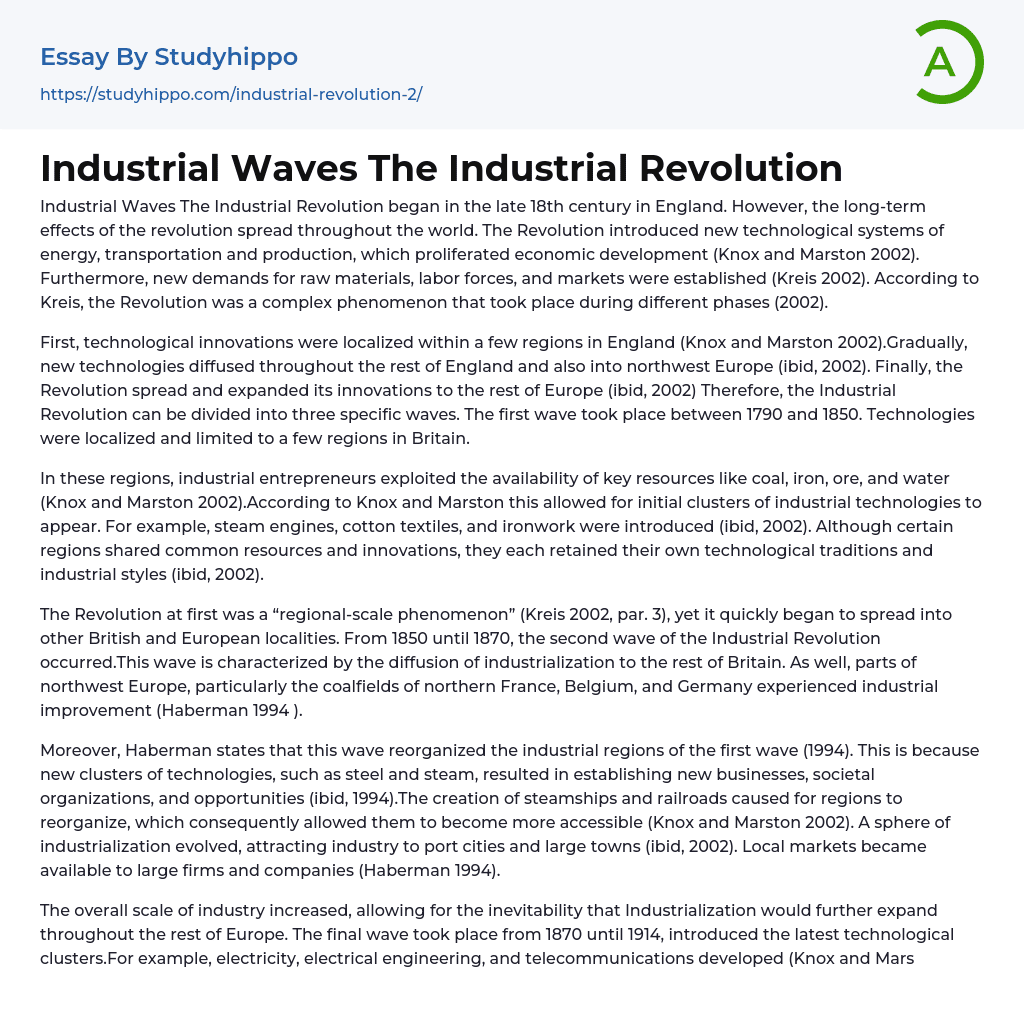Industrial Waves The Industrial Revolution began in the late 18th century in England. However, the long-term effects of the revolution spread throughout the world. The Revolution introduced new technological systems of energy, transportation and production, which proliferated economic development (Knox and Marston 2002). Furthermore, new demands for raw materials, labor forces, and markets were established (Kreis 2002). According to Kreis, the Revolution was a complex phenomenon that took place during different phases (2002).
First, technological innovations were localized within a few regions in England (Knox and Marston 2002).Gradually, new technologies diffused throughout the rest of England and also into northwest Europe (ibid, 2002). Finally, the Revolution spread and expanded its innovations to the rest of Europe (ibid, 2002) Therefore, the Industrial Revolution can be divided into three specific waves. The first wave took place between 1790
...and 1850. Technologies were localized and limited to a few regions in Britain.
In these regions, industrial entrepreneurs exploited the availability of key resources like coal, iron, ore, and water (Knox and Marston 2002).According to Knox and Marston this allowed for initial clusters of industrial technologies to appear. For example, steam engines, cotton textiles, and ironwork were introduced (ibid, 2002). Although certain regions shared common resources and innovations, they each retained their own technological traditions and industrial styles (ibid, 2002).
The Revolution at first was a “regional-scale phenomenon” (Kreis 2002, par. 3), yet it quickly began to spread into other British and European localities. From 1850 until 1870, the second wave of the Industrial Revolution occurred.This wave is characterized by the diffusion of industrialization to the rest of Britain. As well, parts of northwest Europe, particularly the coalfields of
northern France, Belgium, and Germany experienced industrial improvement (Haberman 1994 ).
Moreover, Haberman states that this wave reorganized the industrial regions of the first wave (1994). This is because new clusters of technologies, such as steel and steam, resulted in establishing new businesses, societal organizations, and opportunities (ibid, 1994).The creation of steamships and railroads caused for regions to reorganize, which consequently allowed them to become more accessible (Knox and Marston 2002). A sphere of industrialization evolved, attracting industry to port cities and large towns (ibid, 2002). Local markets became available to large firms and companies (Haberman 1994).
The overall scale of industry increased, allowing for the inevitability that Industrialization would further expand throughout the rest of Europe. The final wave took place from 1870 until 1914, introduced the latest technological clusters.For example, electricity, electrical engineering, and telecommunications developed (Knox and Marston 2002). During this period, industrialization spread to remote parts of France, Germany, and remote parts of The Netherlands, northern Italy, eastern Austria, and also Spain (Haberman 1994). Communication and innovations in electricity allowed for the establishment of trading links.
Industrialization, along with modernization and urbanization, created “a core of prosperity” (Kreis 2002, par. ), called the ‘Golden Triangle’ (ibid, 2002) This area is located from London, to Paris, and to Berlin (ibid, 2002). These cities were able to benefit the most from the opportunities and innovations produced by the revolution. Within Europe, industrialization continued to spread and develop. In addition, growing resource requirements and extensive market opportunities contributed to shaping Europe’s population and regions (Knox and Marston 2002). Knox and Marston state that, “The Industrial Revolution was responsible for the progressive change in Europe’s,
economic, and technological status” (2002, 112).
The Industrial Revolution proved to be a multifaceted phenomenon. The Revolution can therefore be split into three distinctive waves. Primarily, simple technological innovations, like ironwork, were first localized in specialized regions in England. This was followed by the establishment of steamships and railroads, which caused technologies to flourish into the rest of England and other areas of northwest Europe. Lastly, the most modernized technologies, involving communications and electricity, spread into the rest of Europe.The effects of these three waves of the Industrial Revolution allowed for mechanized production and modern economic growth, which continues to spread today.
Works Cited: Haberman, Arthur. The Making of the Modern Age. Toronto: Gage Publishing, 1994. Knox, Paul and Marston, Sally. Places and Regions on Global Context: HumanGeography. London: Prentice Hall, 2003.
Kreis, Steven. “Lecture 17: The Origins of the Industrial Revolution in England. ” TheHistory Guide. 25 July 2002. 23 April 2005.
Available Online: <<www. historyguide. org/intellect/lecture17a. html>>
- Berlin essays
- Pompeii essays
- Paris essays
- Athens essays
- Belgium essays
- England essays
- Germany essays
- Greece essays
- Ireland essays
- Italy essays
- London essays
- Russia essays
- Spain essays
- United Kingdom essays
- Great britain essays
- Rome essays
- British essays
- Birmingham essays
- Afghanistan essays
- Africa essays
- America essays
- Asia essays
- Australia essays
- Caribbean essays
- City essays
- Developing Country essays
- Dubai essays
- Earthquake essays
- Europe essays
- Fracking essays
- Georgia essays
- Middle East essays
- Natural Disaster essays
- New Zealand essays
- North Korea essays
- South Korea essays
- Thailand essays
- Travel essays
- Abolitionism essays
- Adam Smith essays
- American History essays
- American Revolution essays
- Ancient Egypt essays
- Articles Of Confederation essays
- Atlantic Slave Trade essays
- Aztec essays
- Benjamin Franklin essays
- Civil Rights Act of 1964 essays
- Civil Rights Movement essays
- Civil war essays




